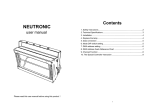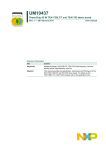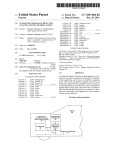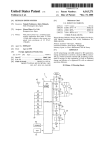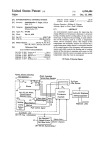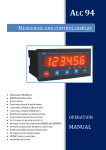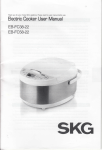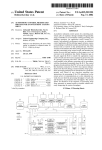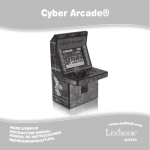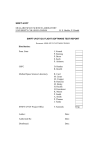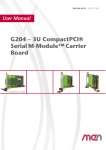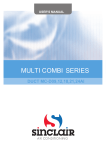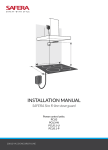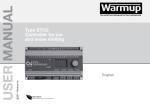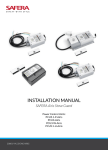Download g Tungsten Shield
Transcript
US 20100290578A1 (19) United States (12) Patent Application Publication (10) Pub. No.: US 2010/0290578 A1 Farrell et al. (43) Pub. Date: (54) DEPLOYABLE ELECTRIC ENERGY (75) REACTOR Inventors: NOV. 18, 2010 Publication Classi?cation (51) J. Paul Farrell, East Setauket, NY (US); James R. Powell, Shoreham, NY (Us) Correspondence Address: Int. Cl. G21 C 1/08 G21 C 3/00 G21C 9/00 G21 C 7/06 G21C 19/00 (200601) (2006.01) (2006.01) (2006.01) (200601) HOFFMANN & BARON, LLP 6900 JERICHO TURNPIKE SYOSSET, NY 11791 (US) (73) Assignee: (52) RADIX POWER AND ENERGY CORPORATION, East Setauket, NY (US) (21) Appl. No.: (22) Filed: 12/778,326 (60) (57) ABSTRACT . . . . . A nuclear ?ss1on reactor devlce includlng a core havlng an May 12, 2010 . US. Cl. ....... .. 376/361; 376/409; 376/288; 376/219; 376/260 array of ?ssile material and Which is capable of being trans . ported to and from the place of operation using conventional Related U's' Apphcatlon Data Provisional application No. 61/177,465, ?led on May 12, 2009, provisional application No, 61/181,123, ?led on May 26, 2009. transportation vehicles. In a ?rst embodiment, the ?ssile material is a Uranium hydn'de enriched 15%-IO-20% With U-235. In a second embodiment, the ?ssile material is a uranium oxide enriched to 18% to 20% With U-235. 250 g \ Tungsten Shield r/ Cool Water Down Flow Channel Outer Porous Cylinder 44/ Packed Bed Of Triso Fuel Particles lnner Porous Cylinder Hot Water Up Flow Channel Thermal Convective Dissipation Of After Heat From Triso Fuel Particles Patent Application Publication Nov. 18, 2010 Sheet 1 0f 8 US 2010/0290578 A1 Grade Lev l f14 f20 Dlrt f18 f22 Above Ground Below Ground FI.1 Patent Application Publication Nov. 18, 2010 Sheet 2 0f 8 US 2010/0290578 A1 FIG. 2 114 114 2 f 100 112 112 $8. f106 1100 HI \/104 1 103 102 110a Patent Application Publication Nov. 18, 2010 Sheet 3 0f 8 US 2010/0290578 A1 FIG. 3 100 108 104 102 103 109 Patent Application Publication E %"\\ (D E, 1.10 4.. g t7) g O Nov. 18, 2010 Sheet 4 0f 8 ‘~ __ 50 MW(e) ‘l'\ "‘x \ \ Keff =1 is the criticallit condition 1.00 US 2010/0290578 A1 [K Q \ - > f; 0.90 6 10 iviwm 0.80 0.70 O 50 100 150 200 250 300 350 400 Operating Time (Days) Keff vs. operating time for DEER using TRIGA fuel at 10 MW(e) output. [In operation, the reactor control rods are used to control Keff.] Total After Heat Beta After'lQlIe'a'tTT” - ~ 0.46 | | | 0.81 1.16 2.32 4.6 Days After Shutdown Afterheat of reactor as a function of time after shutdown 450 Patent Application Publication US 2010/0290578 A1 Nov. 18, 2010 Sheet 5 0f 8 100 (RDGapomtseydar)s MW(e) = 200MW(th)] 0.1 E 3 10 MW(e) = 40 MW(th l 0.01 0 5 10 15 20 25 Distance from surface of reactor (ft) Gamma dose rates after 1000 hours of operation as a function of the distance from the surface of the reactor. Calculation is based on a 20 cm thick tungsten shield with 2.3 days of reactor shutdown. The gamma attenuation factor inside he reactor is assumed to be 10:1. FIG. 7 1000 900 KTempratue, 800 /’ __ ’,’/ " 700 ~\‘e * T(fuel, ctr.) " 600 -- T(fuel,out) .-'I'- ;--'—-_—_-I'_' —--:-_::-_ --- :l::.__.._----------'" 500 -" T(clad,out) -" T(coolant) 400 0 1O 2O 3O 4O 5O 6O 70 Distance from Inlet, cm Temperature of hot fuel elements vs. distance from inlet for 2078 fuel elements, thermal power of 50 MW; fuel element diameter 0.9 cm, core length 60 cm, water temperature 507 K (in), 568 K (out) Patent Application Publication Nov. 18, 2010 Sheet 6 0f 8 US 2010/0290578 A1 FIG. 8a 200 206 202 204 FIG. 80 Water Coolant In Fuel Loading & Unloading Line 210 I J ‘ ‘ Water Coolant Out Water Inlet To Hydraulically Unload Fuel Patent Application Publication Nov. 18, 2010 Sheet 7 0f 8 US 2010/0290578 A1 FIG. 9 250 Triso Fuel Loading/ /Unloading Tube Tungsten Shield / ? Cool Water % % / \y T / Down Flow Channel _____-— Outer Porous Cylinder /q //// \ Packed Bed Of Triso Fuel Particles %" l _ Inner Porous Cylinder Hot Water Up Flow Channel Water Inlet To Hydraulically Unload Triso Fuel Particles Patent Application Publication Nov. 18, 2010 Sheet 8 0f 8 US 2010/0290578 A1 FIG. 10 250 Tungsten Shield / Cool Water Down Flow Channel Outer Porous Cylinder Packed Bed Of Triso Fuel Particles Inner Porous Cylinder Hot Water Up Flow Channel Thermal Convective Dissipation Of After Heat From Triso Fuel Particles Nov. 18, 2010 US 2010/0290578 A1 DEPLOYABLE ELECTRIC ENERGY REACTOR existing types of transport vehicles. Finally, there is a need in the art for a deployable electric energy reactor, Which can be transported from the deployment site after shut doWn With very loW and acceptable radiation doses to the handling and [0001] This application claims the bene?t of Us. Provi sional Application Ser. No. 61/177,465 ?led May 12, 2009 transport personnel. and Us. Provisional Application Ser. No. 61/ 181,123 ?led May 26, 2009, the disclosures of Which are hereby incorpo rated by reference in their entirety. [0002] [0007] The present invention, Which addresses the needs of the prior art, relates to compact transportable nuclear poWer BACKGROUND OF THE INVENTION systems and application modules that canbe rapidly deployed to sites, using existing air and ground transport, to generate The present invention relates to deployable electric electric poWer, condense fresh Water from the atmosphere, and manufacture fuel, fertiliZer, and other needed materials. The nuclear reactor may operate, Without refueling, for peri energy reactors and, more particularly, to a compact readily deployable nuclear reactor system for providing secure emer gency poWer in both civilian and military applications. [0003] With respect to civilian applications, those skilled in the art Will recognize that the Us. electricity system is a very complex, highly interdependent netWork of large poWer plants and long transmission lines that requires constant and precise control. Disruption can rapidly propagate through the infrastructure, causing major portions to fail, as seen in the past. Such events have been triggered by natural causes. Glo bal terrorism raises the possibility of deliberate physical attacks against poWer plants, transmission lines, sub-stations, and other critical government or civilian facilities. Terrorism also includes the possibility of cyber attacks against the com puters that control such systems. Domestic military bases that depend on the civilian electric grid cannot function if it goes doWn for extended times. Natural disasters like hurricanes Katrina and Rita, and earthquakes such as in Haiti in 2010, have shoWn the need for secure emergency poWer. If nuclear, biological, or chemical attacks on cities Were to occur, panic and evacuations could shut doWn much of the Us. electric system for many months. [0004] In addition, the conventional Wisdom about the Us. electric system has been that larger-siZed poWer plants (Whether fossil fuel or nuclear) can produce electrical poWer at a cost per kiloWatt hour that is less than the cost associated With smaller plants. Accordingly, there has been a tendency to build larger poWer plants and, for safety, aesthetic and social political reasons, to locate these larger plants at a distance from the population centers to be poWered. These very large poWer systems incorporate many inherent disadvantages, namely, site preparation, separate radiation shield, siZe of containment building, time and cost of construction, one-of a-kind control system, location near large body of Water for cooling purposes, and others. [0005] SUMMARY OF THE INVENTION With respect to military applications, smaller-siZed nuclear poWer plants have been built for submarines and aircraft carriers. HoWever, outside of those applications, the military has generally relied upon conventional means of generating poWer, e.g., the use of diesel generators. More particularly, When operating in remote areas for long periods ods up to ten (10) years at loW poWer or for periods up to tWo (2) years at full rated poWer. [0008] The nuclear poWer systems are comprised of a pres suriZed light Water reactor (PLWR) steam generator, turbine, and condenser With Water to air or Water to Water heat exchanger. The reactors can be transported to and from their deployment site even after shutdoWn, With very loW and acceptable radiation doses to handling and transport person nel. [0009] TWo distinct nuclear reactor systems are described. The baseline Deployable Electric Energy Reactor (DEER) system uses commercial TRIGA® (loW-enriched (up to 20%), uranium Zirconium hydride (UZrHl_6)) fuel, With Water coolant at standard PWR conditionsl. The DEER reac tor can operate for several years Without refueling, or it can operate for up to 10 years or more at reduced poWer level. After shutdoWn, it is removed to an appropriate site for refu eling or disposal. If needed, a neW DEER reactor can be installed at the location. The advanced Ultra compact, Ultra high poWer Deployable Electric Energy Reactor (DEER-U2) system uses existing TRISO2 fuel particles in porous fuel elements With direct ?uid cooling of the particles. After shut doWn, the spent TRISO fuel particles are hydraulically unloaded into a compact shielded transport cask for disposal. Fresh TRISO fuel particles are then loaded for the next oper ating cycle. DEER and DEER-U2 use up to 20% enriched fuel, and operate for years per fuel loading. The reactor mod ules and separate steam turbine-generator modules are pref erably integrated at the operating site. In one embodiment, turbine inlet conditions are saturated steam at 1000 psi. If only air cooling is available at the operating site, turbine exhaust pressure is preferably 15 psi, With a thermal cycle ef?ciency of 25%. If Water cooling is available, turbine exhaust pressure is preferably 2 psi, With a cycle ef?ciency of 30%. l LOW-enriched, long-lifetime uranium Zirconium hydride (UZrH) fuel is an important feature of the TRIGA® family of reactors. The large prompt negative temperature coef?cient of reactivity characteristic of UZrH1_6 fuel results in safety margins far above those achieved by any other research reactor fuel. Large reactivity insertions are readily accommodated and are routine operation of time (e.g., deployments in Iraq and/or Afghanistan) the for some applications. Inadvertent reactivity insertions have been demon military is often required to continuously run generators, typically burning diesel fuel. The largest of these diesel gen poWer after loss of forced ?oW cooling (and resultant poWer scram) has been erators are on the order of 750 kiloWatts, and require a con stant supply of diesel fuel, Which in a remote setting is often dif?cult (as Well as expensive) to provide. [0006] Accordingly, there is a need in the art for a deploy strated to produce no fuel damage in TRIGA cores. Power coast-down from ?ill demonstrated to be a very benign event With the reactor immediately available to return to ?ill poWer. 2 INEEL/EXT-05-026l5, “Development ofImproved Models and Designs for Coated-Particle Gas Reactor Fuels,” Idaho National Engineering and Environ mental Laboratory, December 2004 [0010] In one preferred embodiment, the system includes a able electric energy reactor Which can provide secure emer core of UZrHL6 fuel enriched up to 20% With U-235. The gency poWer for both civilian and military applications. There is a further need in the art for a deployable electric energy system preferably includes an atmosphere of ?oWing Water passing through the core, and a pressure vessel for containing reactor Which is both compact and quickly deployable using the core and the Water coolant at pressure in the range 1500 Nov. 18, 2010 US 2010/0290578 A1 psig (100 atmospheres:l 0 MPa). The system further includes an integral conformal radiation shield that has a thickness and density suf?cient to attenuate the high energy gamma rays emitted by the core during operation and after the reactor is shut doWn. Moreover, the system preferably includes a set of movable control rods containing a neutron absorbing material for controlling release of energy from the core. Finally, the system preferably has a total reactor Weight Which alloWs transportation on conventional vehicles. [0011] In another preferred embodiment With the potential to operate at a peak thermal poWer of 40 megaWatts, the core is cylindrically shaped and measures approximately 50 cm to 60 cm in diameter and approximately 55 to 65 cm in height. including an outer radiation shield having tWo coaxial porous cylinders With an annular space betWeen the inner and outer cylinders. [0015] As a result, the present invention provides a deploy able electric energy reactor for providing secured emergency poWer in both civilian and military applications. The present invention further provides a system that is compact and quickly deployable using existing types of transport vehicles. Finally, the present invention provides deployable electric energy reactors having integral gamma shields, Which can be transported from their deployment site after shut doWn With very loW/acceptable radiation doses to the handling and trans port personnel. The core is preferably separated by a gap of approximately BRIEF DESCRIPTION OF THE DRAWINGS 0.5 cm to 1.5 cm from a conformal coaxial neutron re?ector. In turn, the core is preferably enclosed in a conformal neutron re?ector having a thickness of approximately 5 cm. The neu tron re?ector is in turn preferably enclosed in an integral conformal pressure vessel having a thickness of at least about 3.0 cm of steel. The pressure vessel is in turn preferably enclosed in a conformal integral radiation shield having a thickness of at least about 20 cm to 25 cm of high density material such as tungsten or tantalum. [0012] In another preferred embodiment With the potential to operate at a peak thermal poWer of 200 megaWatts, the core is cylindrically shaped and measures approximately 120 cm in diameter and approximately 120 cm in height. The core is preferably separated by a gap of approximately 0.5 cm to 1.5 [0016] FIG. 1 is a schematical vieW of the modular compo nents of the present invention; [0017] FIG. 2 is an elevation vieW of a 10 MW(e) DEER reactor formed in accordance With the present invention; [0018] FIG. 3 is a cross-sectional vieW of the core of the reactor of FIG. 2; [0019] FIG. 4 is a graphical representation shoWing the critically constant, Key, verses operating time for a 10 MW(e) DEER Reactor using TRIGA fuel; [0020] FIG. 5 is a graphical representation shoWing the afterheat of the 10 MW(e) reactor as a function of time after shut doWn; [0021] FIG. 6 is a graphical representation of the gamma dose rates after 1,000 hours of operation as a function of the distance from the surface of the reactor; [0022] FIG. 7 is a graphical representation of the tempera cm from a coaxial neutron re?ector. In turn, the core is pref erably enclosed in a conformal neutron re?ector having a thickness of at least about 5 cm. The neutron re?ector is in turn preferably enclosed in an integral conformal pressure vessel having a thickness of at least about 3 .0 cm of steel. The pressure vessel in turn is preferably enclosed in a conformal integral radiation shield having a thickness of at least about 20 cm to 25 cm of high density material such as tungsten or tantalum. the inlet; [0013] shoWing the ?uid ?oW paths; In another preferred embodiment, the present inven tion relates to a nuclear ?ssion reactor system With a core including an array of cylindrical fuel elements that contain Tristructural-isotropic (TRISO) fuel particles enriched up to 20% With U-235. The core preferably includes an array of porous fuel elements, for containing the TRISO fuel particles. The system preferably includes an atmosphere of ?oWing coolant passing through the core. The system also preferably ture of the hot fuel element as a function of the distance from [0023] FIG. 8a is a cross sectional vieW ofthe core ofthe ultra high poWer, ultra compact DEER-U2 reactor; [0024] [0025] FIG. 8b is a cross sectional vieW of the fuel element; FIG. 80 is an elevation vieW of the fuel element [0026] FIG. 9 is an elevation vieW of a fuel storage/trans port cask for the DEER-U2 reactor; and [0027] FIG. 10 is a cross-sectional vieW of the fuel storage/ transport cask of FIG. 9. DETAILED DESCRIPTION OF THE INVENTION includes a pressure vessel that contains the core and the [0028] coolant at a pressure in the range of 1500 psig (100 atmo systems of the present invention preferably include a reactor spheres:l0 MPa). The system preferably includes a set of movable control rods containing a neutron absorbing material for controlling release of energy from the core. Finally, the system preferably has a total reactor Weight Which alloWs transportation on conventional vehicles. module 10, a poWer conversion module 12, a Waste heat [0014] vehicle fuel and/ or for production of fertiliZer. [0029] PoWer conversion module 12 can include any In another preferred embodiment, the fuel elements are formed from coaxially-arranged porous cylinders, With the TRISO particles being packed into the annular space betWeen the tWo cylinders. Preferably, the inlet coolant ?oWs directly into and along the central cylindrical channel of each fuel element and then radially outWards through the porous cylinder Wall into the annular-packed particle beds, and then out of the particle beds into the body of the pressure vessel, removing the ?ssion heat from the TRISO particles. The TRISO fuel particles are preferably transferred hydraulically betWeen a separate external storage cask and the reactor fuel assembly. The system preferably includes a fuel transfer cask Referring to FIG. 1, the deployable nuclear reactor rejection module 14, and depending on needs of the operating site, a set ofprocess modules 16, 18, 20*Wh1Ch can be used for production of fresh Water, hydrogen fuel, synthetic vehicle fuel and/or ammonia, the ammonia being used for knoWn apparatus for converting high temperature ?uid (liq uid or gas) to a usable source of output poWer (e.g., electric ity) such as a steam turbine generator. Waste heat rejection module 14 is preferably con?gured to Work in conjunction With poWer conversion module 12 to facilitate a thermody namic cycle. When used in conjunction With a steam turbine generator, the Waste heat rejection module 14 Will condense the turbine exhaust steam using coolant Water (if available), or by using an air cooled heat exchanger. The various process modules Would be used under appropriate circumstances. It Nov. 18, 2010 US 2010/0290578 A1 Will be appreciated by those skilled in the art that the module nuclear fuel consists of small particles, each about 30 mils design of the system facilitates transportation, assembly and (0.7 millimeter) in diameter. The TRISO particles are packed disassembly of the individual components, and alloWs the into fuel elements and are directly cooled by a ?uid medium, system to be readily con?gured on site in the desired manner With the desired parameters. [0030] As shoWn in FIG. 1, the reactor module 10 is pref erably positioned beloW ground level and/ or Within an enclo sure 22 formed of cement or other suitable shielding material. The location of reactor module 10 at an underground position provides additional shielding for the DEER reactor, and as e.g., Water, helium, argon. The packed particles in the DEER U2 fuel elements can be hydraulically unloaded and fresh particles loaded back, enabling the reactor to be periodically refueled Without opening the pressure vessel. Ten (10) and 50 MW(e) designs of the DEER and DEER-U2 poWer levels bracket the range of interest and maximum Weight for deploy able systems. If more than 50 MW(e) is desired at a site, discussed further hereinbeloW, provides the necessary shield ing for the DEER-U2 reactor during operation. It Will also be additional units could be deployed. [0035] The DEER-U2 reactor is designed to produce high appreciated that the location of the reactor module 10 at an underground position provides an additional level of security poWer With less siZe and Weight than the DEER reactor. Furthermore, the DEER-U2 reactor is designed to be more against tampering, and in battle?eld locations, can provide an readily transportable using conventional vehicles and to have additional level of protection against attempted sabotage and/ a fuel system that can be reloaded in situ. or directed military strikes. [0031] The ?rst embodiment of the present invention, i.e., the DEER system, is a fully sealed reactorusing UZrHL6 fuel. The DEER reactor is not refueled at the site. After reaching its reactivity limited lifetime, the reactor module Will be trans ported aWay for refueling or disposal and a neW module brought to the site, if desired. For disaster relief, one reactor The Deer Reactor [0036] TABLE I Preferred Design Parameters for the DEER Reactor module per mission Would likely be suf?cient. For poWer/ Water/fuel/ fertilizer production, additional modules Would be Reactor Parameters necessary. The removed DEER module has an integral Thermal PoWer MW(th) 40 200 gamma shield that limits radiation dosage to handling and Cycle Ef?ciency (%) 25 25 transport personnel to values Well beloW existing guidelines. Reactor OD (m) Module OD (m) With 0.2 (m) Shield Reactor Core OD (m) Reactor Core Length (m) Fuel Element Diameter (cm) Fuel Elements in Core # 0.63 1.09 0.53 0.6 0.9 2078 1.30 1.74 1.2 1.2 1 5149 There is no residual radioactivity at the operating site after the end of the mission. [0032] The second embodiment of the present invention, i.e., the DEER-U2 design, uses TRISO fuel particles that are hydraulically unloaded from the reactor after shutdoWn, enabling periodic refueling even though the reactor vessel is sealed. The particle unloading/loading uses small diameter pipes that are valved shut during operation. Spent TRISO fuel particles are loaded into a compact, fully shielded transport cask. The shielding for the DEER-U2 reactor may include dirt, sand, Water or other locally available material. Because the DEER-U2 reactor does not require an integral shield, the DEER-U2 system Weighs much less than that DEER system. 10 MW(e) 50 MW(e) Uranium in UZrH1_6 Fuel (Wt. %) 30 30 Uranium Wt. in Core (kg With 20% U-235 37 226 Enrichment) Reactor Wt. W/Fuel (metric tons) Module Wt. W/Shield (metric tons) [0037] 1.3 13 7.4 40 Computer simulations Were used to determine the design parameters of the DEER modules using MCNP3 Monte Carlo code and MonteBurns4 Monte Carlo code, both of Which are available to those skilled in the art. The MCNP The DEER-U2 reactor can remain at a site for as long as Monte Carlo code models criticality, poWer distribution, con poWer output is needed. [0033] There are tWo preferred DEER reactor siZes, namely trol rod Worth, void coe?icient, temperature coe?icient, etc. 10 MW(e) and 50 MW(e). The 10 MW(e) module’s thermal poWer is 40 MW(th), based on a cycle ef?ciency of 25%, and a turbine exhaust pressure of 15 psi for Waste heat reaction to the atmosphere. The 50 MW(e) module’s thermal poWer is 200 MW(th). If Water cooling is available, the poWer outputs Would be 12 MW(e) and 60 MW(e), respectively. [0034] The DEER-U2 reactor uses Well developed Tri structural-isotropic (TRISO) fuel. The TRISO fuel consists of a fuel kernel composed of UO2 (i.e. UOX) (sometimes UC or UCO) in the center, coated With four layers of three isotropic materials. The four layers are a porous buffer layer made of carbon, folloWed by a dense inner layer of pyrolytic carbon (PyC), folloWed by a ceramic layer of SiC to retain ?ssion products at elevated temperatures and to give the TRISO particle more structural integrity, folloWed by a dense outer layer of PyC. TRISO fuel particles are designed not to crack due to the stresses from processes (such as differential ther mal expansion or ?ssion gas pres sure) at temperatures beyond 16000 C., and therefore can contain the fuel in the Worst of accident scenarios in a properly designed reactor. The TRISO With great accuracy, While the MonteBurns Monte Carlo code folloWs the neutronic behavior of the reactor over its operat ing life as the U-235 fuel burns out and ?ssion products build up. Three dimensional Monte Carlo neutronic analyses are accurate and predict reactor performance With high precision. Monte Carlo predictions of the various neutronic parameters for the SNTP/PBR nuclear propulsion reactor, Which is com parable in siZe to the DEER reactors, agreed at the 1% level With experimental measurements on the actual PBR critical assemblies. 3 MCNPiA General Monte Carlo N-Particle Transport Code, Version 4C, 1. F. Breismelster, Ed., Los Alamos National Laboratory, LA 13709-M, March 2000. 4 D. L. Poston, and H. R. Trellue: User’s Manual, Version 2.0 for MONTE BURNS Version 1.0, LA-UR-99-4999 (September 1999) [0038] Referring noW to FIGS. 2-3, a 10 MW(e) DEER reactor 100 includes a core 102, a re?ector 104, a pressure vessel 106 and a shield 108 (shoWn in FIG. 3). The core is cylindrically shaped and measures approximately 50 cm to 60 cm in diameter and approximately 55 to 65 cm in height. As best seen in FIG. 3, core 102 is preferably separated by a gap 103 of approximately 0.5 cm to 1.5 cm from conformal Nov. 18, 2010 US 2010/0290578 A1 tungsten or tantalum. A plurality of fuel rods 109 are posi tion Will continue from the radioactive decay of its ?ssion products. This small afterheat continues to decrease With time after shutdoWn. [0043] FIG. 5 shoWs the afterheat thermal poWer folloWing shutdoWn for the 10 MW(e) DEER reactor. TWo days after shutdoWn, the thermal poWer is 150 kiloWatts, about 0.3% of the 40 megaWatts generated at full poWer. Approximately one-third is from short range beta particles, Which stop inside the reactor, and tWo-thirds is from gamma photons, Which require shielding. Contributions of gamma and beta radiation tioned in core 102. are shoWn separately. The calculations are based on 10 [0039] MW(e) [40 MW (thermal)] after 1000 hours of operation. coaxial neutron re?ector 104. In turn, conformal neutron re?ector 104 preferably has a thickness of approximately 5 cm, and is preferably formed by the pressurized Water con tained Within the pressure vessel. Neutron re?ector 104 is in turn preferably enclosed in an integral conformal pressure vessel 106 having a thickness of at least about 3 cm of steel. Pressure vessel 106 is in turn preferably enclosed in a con formal integral radiation shield 108 having a thickness of at least about 20 cm to 25 cm of high density materials such as A plurality of movable control rods 11011, b, c, d are located inside of pressure vessel 106. The control rods can be [0044] moved betWeen a ?rst position Wherein they are fully extended Within core 102 (see control rod 110 a) and a second position Wherein they are fully WithdraWn from core 102 (see control rod 110 b). The control rods are preferably formed sten or tantalum gamma shield that attenuates the external The DEER reactors have an enclosing thick tung preferably located external to the pressure vessel, and com municates With a drive mechanism 112 located inside the pressure vessel Whereby the control rods can be moved into dose from the radioactive fuel inside the shut-doWn reactor, so that personnel can safely remove and transport it aWay from the site. FIG. 6 shoWs the gamma dose in rads per day as a function of distance from the shield surface, based on a 20 centimeter thick shield at 2.3 days after shutdoWn. For the 10 MW(e) reactor, at 10 feet the radiation dose is 0.05 rad per day. The alloWable dose for radiation Workers is 5 rads per year. To receive this dose, the Worker Would have to remain at 10 feet from the shield for 100 days, assuming the dose rate stayed constant at the 2.3 day level. HoWever, since the after heat and gamma photon release rate rapidly decrease With time, the Worker Would not receive 5 radsino matter hoW long the Worked remained in proximity to the reactor. The dose rate for the 50 MW(e) reactor is ~0.25 rad per day. At 10 feet for 20 days, a Worker Would receive 5 rads at the 2.3 day and out of the core Without any breaches of the pressure release rate. from a neutron absorbing material such as boron, Which lim its/prevents the ?ssion process When the control rods are fully inserted into the core. When the control rods are fully With draWn from the core, the reactor Will operate at maximum poWer. The poWer of the reactor can be regulated by moving one or more control rods into the core. In one embodiment, each of control rods 11011, b, c, d may be individually adjusted to provide greater adjustability of the poWer output of the reactor. The control panel for moving the control rods is vessel. A plurality of housings 114 preferably extend from the [0045] pressure vessel to provide the vertical height necessary to fuel element located at the center of the DEER reactor core, Which has the greatest poWer density, as a function of distance from the coolant inlet. Maximum temperature at the center of alloW the contact rods to be fully WithdraW from the core. [0040] In one preferred embodiment, fuel rods 109 are arranged in a symmetric matrix Within the core and the con trol rods are concentrated toWard the center of the core. In another preferred embodiment, the matrix is formed With a pentagonal cross-section. [0041] FIG. 4 shoWs the criticality constant, Kefas a func tion of time for the 10 and 50 MW(e) designs, as predicted by the MCNP and MonteBums codes. The DEER reactor oper ates as long as Ke?is greater than, or equal to 1.00 (When Kef is greater than 1.00, control rods keep the actual Kejfl .00). The DEER fuel contains a burnable neutron poison to mini miZe the sWing in Kefover reactor lifetime. For the 10 MW(e) design, Ke? reaches its limit of 1.00 after 300 days of full poWer operation. At this point, the DEER reactor Would be removed and transported to a site to be refueled or decom FIG. 7 shoWs the temperature distribution along the the fuel element is 970 K, Well beloW the maximum tempera ture capability of the TRIGA fuel, and comparable to the maximum temperature for steady state operation in previous TRIGA reactor designs. The heat transfer analyses shoWn in FIG. 7 illustrates the AT’s for the various steps in the heat transfer process, ie the AT from the center of the hydride fuel to the outer surface of the fuel, the AT betWeen the outer surface of the hydride and the inner surface of the stainless steel cladding, the AT across the Water ?lm from the outer surface of the cladding to the bulk of the Water coolant. The largest AT is that betWeen the center of the hydride fuel and its outer surface, being about 200 K at the center of the reactor. The analysis Was for a thermal poWer of 50 MW, an early design version of the MW(e) unit. The present thermal rating missioned. [0042] The Monte Burns analysis indicates that the 50 is 40 MW(th), Which reduces each of the AT’s by a factor of MW(e) reactors Will operate considerably longeriWell over 425 daysiand likely up to 600 days before replacement. If The Deer-U2 Reactor the reactor does not alWays operate at full output, the reactor 0.8, making the maximum fuel temperature ~900 K. [0046] module Would not require replacement until its integrated output reached 300 full poWer days for the 10 MW(e) design and ~600 full poWer days for the 50 MW(e) unit. Also, the TABLE II designs assume a 30 Weight percent loading of uranium in the Preferred Design Parameters for the DEER-U2 Reactor Based on Fuel Element With Hvdraulicallv Loaded/Unloaded TRISO Particles UZrHL6 hydride fuel. Higher uranium Weight loadings are practical, up to at least 45%, Which could double operation Reactor Parameters l0 MW(e) 50 MW(e) lifetime. The DEER fuel enrichment is up to 20% U-235, Which is not usable for nuclear Weapons. TWenty percent Thermal PoWer (MW) 40 200 Cycle Ef?ciency (%) 25 25 Reactor OD (cm) Reactor Core OD (cm) 65 45 92 71 (20%) enriched fuel is Widely used and does not require safeguards. When the DEER reactor is shut doWn and trans ported aWay from its operating site, thermal energy genera Nov. 18, 2010 US 2010/0290578 A1 [0050] As discussed earlier, the DEER-U2 reactor uses small TRISO nuclear fuel particles that are hydraulically loaded into and out of the reactor. In the DEER-U2 system, TABLE II-continued Preferred Design Parameters for the DEER-U2 Reactor Based on Fuel Elements with Hvdraulicallv Loaded/Unloaded TRISO Particles Reactor Parameters 10 MW(e) 50 MW(e) Reactor Core Length (cm) 100 176 # of Fuel Elements in Core 37 91 Fuel Element OD (cm) Thickness of TRISO Bed in Fuel Element 6.0 1.45 6.0 1.45 0.78 0.78 (Cm) Average Power Density in TRISO Bed MW(th)/liter Initial U-235 Loading in Core (kg) 50% Bumup Lifetime (mos) Weight of Reactor, incl. Fuel (metric tons) [0047] 14.6 6 1.25 73.0 6 4.5 FIGS. 811-80 illustrate the DEER-U2 reactor. Refer ring to FIG. 8a, DEER-U2 reactor 200 includes a reactor core 202, a neutron re?ector 204 and a pressure vessel 206. A plurality of fuel elements 210 are positioned within the reac tor core. As explained further hereinbelow, reactor 200 does not require and/ or include an integral shieldialthough an outer shield layer can be added to attenuate small residual radiation levels. [0048] Those skilled in the art will recognize that the mate rials used to shield a nuclear reactor are extremely dense and the fuel elements are designed so that the TRISO fuel par ticles can be hydraulically unloaded and loaded. The small diameter of the TRISO particles enables them to be hydrau lically loaded into and removed from fuel element structures inside the reactor, without the need to physically open the reactor. The DEER-U2 reactor includes a plurality of fuel elements 210 positioned within core 202. As best shown in FIGS. 8b and 80, each fuel element 210 includes an inner cylinder 212, and an outer cylinder 214.An annular space 216 is thereby de?ned between the outer surface of cylinder 212 and the inner surface of cylinder 214. The TRISO fuel par ticles 218 are packed within annular region 216. Each of cylinders 212 and 214 are porous in design whereby a coolant ?uid can pass through the walls of the cylinders. As best seen in FIG. 80, a coolant ?uid (e.g., water) is directed into inner cylinder 212. The water travels through the porous walls of inner cylinder 212 into annular region 216. The water there after ?ows through the walls of porous outer cylinder 214 whereby it then exits the reactor core 202. [0051] The TRISO fuel is packed into annular region 216 between two porous cylinders. In operation, water coolant ?ows in through and along the central channel inside the inner cylinder. The coolant then ?ows radially outwards through heavy, thereby forming the substantial portion of the overall the packed bed of TRISO particles to exit from the reactor. weight of the reactor. In other words, when considering a transportable nuclear reactor, such as the DEER reactor dis particles but large enough to provide su?icient cooling. Pore cussed hereinabove, the 10 MW(e) unit weighs approxi mately 13 metric tons with the integral shield, whereas the reactor alone weights approximately 1.3 metric tons. Although small and light enough to be transportable, the DEER reactor discussed hereinabove nonetheless weighs 13 metric tons, which requires a certain level of equipment for transportation and handling thereof. The ability to eliminate the integral shield from the reactor unit substantially reduces the weight of such unit, thereby greatly increasing the trans portability and ease of handling of the unit. Stated differently, transporting and handling a reactor weighing 1.3 metric tons is substantially easier than transporting and handling a reactor weighing 13 metric tons. The requirement to preload a trans portable reactor with fuel necessitates the need for an integral shield, and thus the overall weight of the unit. [0049] The ability to remove the integral shield from the reactor is accomplished through the design of the novel fuel elements of the DEER-U2 reactor, together with the usage of fuel having certain characteristics. More particularly, the DEER-U2 reactor has been designed such that it can be loaded with the necessary fuel after it is has been transported to the selected site, and after it has been con?gured and setup. This setup would involve installing the DEER-U2 reactor below ground and/or within a protected enclosure. Due to the light weight of the DEER-U2 reactor, this installation/ setup is readily accomplished. Once setup, the fuel is then loaded into the reactor core (as discussed hereinbelow), whereby a ?ssion reaction can be initiated. The surrounding dirt and/ or enclo sure provide the necessary shielding while the reactor is in use. If and when it is time to remove the reactor from the selected site, the radioactive fuel is unloaded from the reactor core in the reverse manner, thereby leaving the reactor core empty of radioactive material. The reactor core can thereafter be removed from the site with no risk to the personnel trans porting the unit. The pores are chosen small enough to contain the TRISO siZe is chosen to control individual coolant ?ow at every (r,0,Z) location on each fuel element. [0052] The TRISO fuel is transported to and from the reac tor vessel in a separate shielded transport cask. The fuel is then hydraulically transferred between the transport cask and the fuel elements located inside the reactor pressure vessel. In the fuel unload transfer mode, the reactor water coolant is directed in through the bottom of the fuel element, ?uidiZing the settled particle bed and causing the particles to ?ow out with the water through the top of element into the external spent fuel storage cask. To hydraulically load fresh fuel par ticles into the DEER-U2 reactor, the ?uidized particles are introduced into the top of the elements. The down-?owing particles are then trapped by the porous frit at the bottom of each element, building up the annular bed in the element. [0053] The inlet water coolant ?ows along the central cylin drical channels inside the particle bed fuel elements and then radially outwards through the annular packed particle beds, removing the ?ssion heat from the TRISO particles. The annular particle bed is held between two coaxial cylindrical porous frits, which form the fuel element. [0054] The pressure drop for water ?ow through the ?ts is preferably several times greater than the pressure drop through the particle bed so that each local portion of the bed experiences the proper water ?ow rate, and the temperature of the water coolant existing through the outer frit is essentially the same everywhere in the reactor. Frits are preferably con ?gured to control individual coolant ?ows at every (r,0,Z) location on each fuel element in the reactor core so that the outlet coolant is at the same temperature everywhere. [0055] FIGS. 9-10 show a fuel storage/transport cask 250 for the 10 MW(e) DEER-U2 TRISO reactor. The spent TRISO fuel particles are immersed in liquid water inside the enclosing shield/container vessel. The shield attenuates the gamma radiation enough from the ?ssion products that the Nov. 18, 2010 US 2010/0290578 A1 handling/transport personnel do not receive excessive radia tion dosages. The decay heat deposited in the TRISO fuel particles (primarily from beta particle decay, Which is about locking ends such that opposite segments can be joined together to form a complete 360 degree circular segment enclosing an approximately 10 cm axial length of the one-third of total decay heat) is transferred to the Water bath in Which the particles are immersed, and then by convection pressure vessel. 4. The nuclear ?ssion reactor according to claim 2, Wherein said radiation shield is made of a tantalum alloy, said alloy to the shield. being segmented into semicircular sections, said semi circular segments having an axial length of approxi mately 10 cm, said semicircular segments having inter locking ends such that opposite segments can be joined [0056] Although the storage/transport casks do require shielding, Which substantially increases the Weight of such cask, it Will be appreciated that the Weight of a shielded cask Will be substantially less than the Weight of a shielded reactor together to form a complete 360 degree circular segment enclosing an approximately 10 cm axial length of the such as the DEER reactor described hereinabove. Moreover, it Will be appreciated that multiple smaller- siZed casks may be used to load a DEER-U2 reactor, rather than one larger cask. In this manner, the siZe and Weight associated With each discrete cask can be designed Within preselected parameters. In one preferred embodiment, the individual casks are siZed to have a Weight on the order of one ton Whereby the trans portation/ lifting equipment can easily move all such compo nents. [0057] This energy, plus the gamma energy deposited in the shield, is then conducted through the shield to the outer sur face of the cask. From there, natural convection, Which may be augmented by fans, transfers the thermal energy to the ambient atmosphere. Natural convection currents in the Water bath transfer the thermal energy to the inner surface of the shield. In an alternative embodiment, the natural convection currents are augmented With a small electrically poWered circulator. [0058] It Will be appreciated that the present invention has been described herein With reference to certain preferred or exemplary embodiments. The preferred or exemplary embodiments described herein may be modi?ed, changed, added to or deviated from Without departing from the intent, spirit and scope of the present invention, and it is intended that all such additions, modi?cations, amendments and/or devia tions be included in the scope of the present invention. What is claimed is: 1. nuclear ?ssion pressuriZed light Water reactor, compris ing: a reactor core, said reactor core including a plurality of uranium Zirconium hydride fuel rods, each of said fuel rods having a diameter of approximately 1 cm and being arranged in a symmetric matrix; a pressure vessel surrounding said core, said pressure ves sel having an external conformal radiation shield made SD of a heavy metal, said pressure vessel including penetra tions for inlet and outlet How of pressuriZed Water; and plurality of control rods located Within said pressure vessel and movable betWeen a ?rst position Wherein said control rods are extended Within said matrix to limit ?ssion Within said core and a second position Wherein said control rods are WithdraWn from said matrix to alloW ?ssion Within said core. 2. The nuclear ?ssion reactor according to claim 1, Wherein said uranium Zirconium hydride fuel rods are formed of up to 20% U-235 enriched uranium and up to 45% ratio of uranium to Zirconium by Weight. 3. The nuclear ?ssion reactor according to claim 2, Wherein said radiation shield is made of a tungsten alloy said alloy being segmented into semicircular sections, said semi circular segments having an axial length of approxi mately 10 cm, said semicircular segments having inter pressure vessel. 5. The nuclear ?ssion reactor according to claim 2, Wherein said matrix is formed With a pentagonal cross-section. 6. The nuclear ?ssion reactor according to claim 2, further comprising a controller located external to said pressure ves sel for moving said control rods betWeen said ?rst and second positions. 7. The nuclear ?ssion reactor according to claim 6, Wherein said control rods are formed from a neutron absorbing mate rial. 8. A nuclear ?ssion reactor, comprising: a reactor core, said reactor core including an array of fuel elements containing tristructural-isotropic fuel par ticles, said fuel particles being enriched up to 20% With U-235, said fuel elements being formed from axially arranged porous cylinders, said cylinders de?ning an annular region therebetWeen and Wherein said fuel par ticles are packed into said annular region; and a pressure vessel surrounding said core, said pressure ves sel including penetrations for inlet and outlet How of a coolant through said core. 9. The nuclear ?ssion reactor according to claim 8, Wherein said coolant is Water, said Water operating at pressure in the range of 1500 psi (100 atmospheres:l0 MPa). 10. The nuclear ?ssion reactor according to claim 8, Wherein said coolant is a pressuriZed ?oWing gas under a nominal pressure on the order of 1000 psi. 11. The nuclear ?ssion reactor according to claim 10, Wherein said gas is helium 12. The nuclear ?ssion reactor according to claim 10, Wherein said gas is argon. 13. The nuclear ?ssion reactor according to claim 8, Wherein said coolant ?oWs into the interior of the inner cyl inder of said fuel element and thereafter ?oWs through the porous Wall of the inner cylinder into said annular region containing said fuel particles thereby removing the ?ssion heat generated by said fuel particles. 14. The nuclear ?ssion reactor according to claim 8, further comprising an external transfer cask for holding and storing said fuel particles; and Wherein said fuel is transferred hydraulically betWeen said cask and said fuel elements, said cask including an outer radiation shield having tWo coaxial porous cylinders With an annular space betWeen the inner and outer cyl inders. 15. The nuclear ?ssion reactor according to claim 14, fur ther comprising means to hydraulically transfer said fuel particles betWeen said fuel transfer cask and said fuel ele ments located in said core. * * * * *















